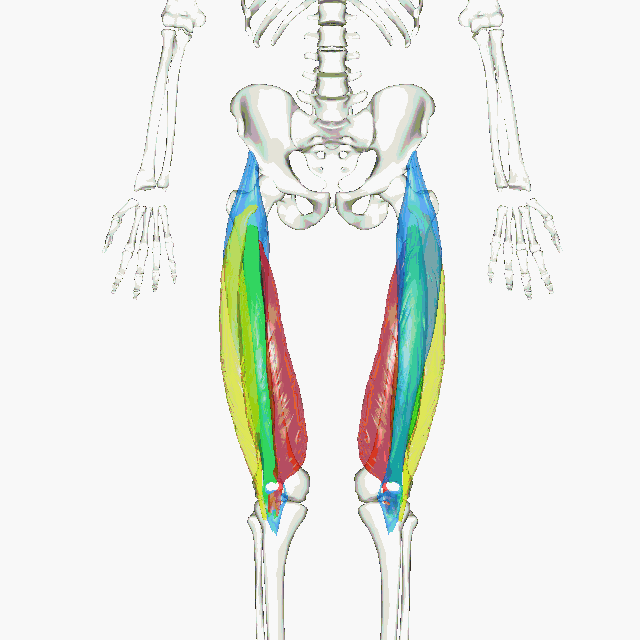The Quads
Let's get back to muscles and talk quads. That huge group of, yes 4, knee extensor muscles on the anterior thigh. Nothing like a good set of quads, but what do they do and why do we need them?
Well, together this group of muscles is able to generate more force than any other muscle except for the maybe the mighty gluteus group. I say maybe because some people have overdeveloped quadand are "quad dominant" in their movements, but more on that later.
In conjunction with the glutes' hip extension, knee extension helps you push off the ground when you are running or jumping. This action of hip extension with knee extension is really central to many sports movements, even ones where you think strong quads are not needed. Of course, to jump and spike a volleyball, you will need strong quads, which is why those volleyball players have such impressive thighs and glutes, but also when throwing a ball, pitcher push off the ground generating power by moving their body forward and rotating their hips and upper body off of that strong base. And if you just show up to the gym for fitness sake, then almost any movement that involves lifting weight up from the ground will involve the quads.
But we are getting ahead of ourselves, in order to know the muscles action, we must know it's anatomy because form follows function. The origin of the quads depends on which portion of the muscle you are talking about. Although the quadriceps femoris is considered one muscle because it tapers down to a single tendon on the knee, it really has four distinct muscle bellies, three of which can be visualized on a fit and trim individual.
While you're seated reading this, kick your knee out and hold it. Now the quads are the ONLY muscles that extend the knee. Place your hand on the patella, your knee cap. This is actually a sesamoid bone, a bone that develops within a tendon. This, the largest of the sesamoid bones, protects the tendon from damage and slides in a groove along the end of the femur. Feel to the bottom of the patella where it becomes a thick, tense tendon, This is the patella tendon, which below the patella attaching to the lower leg bone the tibia at the tibial tuberosity further down. Above the patella is the quadriceps tendon, but these two tendons with the patella sandwich in between are really just one extensor mechanism, without which, of course the knee would not extend when your quads fired.
All 4 heads of the quadriceps insert here at the quadriceps tendon, but originate from different area above. Are you still holding that knee out??? Good. Move your hand medially (toward the midline) and you will feel a tense muscle, maybe even see a little teardrop or admire it on this ballerina here. This is the vastus medialis, and it only extends the knee. This is because it originates on the upper femur and crosses just one joint, the knee. Of course, the vastus lateralus is on the lateral (outside) portion of the leg and makes up the majority of the thigh from the pocket of your jeans to your knee. It also just extends the knee for the same reason. This puts the vastus intermedius in the middle of the two vasti and does the same. Three heads with slightly different origins up near the top of the femur.
Now for the 4th quad muscle head, the rectus femoris, and it covers the entirety of the vastus intermedius. It shares the quadriceps tendon distally, but also crosses the hip joint originating at the hip bone structure called the ASIS (anterior superior iliac spine). This makes the rectus femoris both a knee extensor and a hip flexor.
WHY FOUR MUSCLES TO DO ONE JOB?
When we think of knee extension we usually think of kicking a ball or sitting on that silly knee extension machine with your shin on the pad. Well, that is knee extension, but it is hardly difficult to do either. In those movements the thigh is fixed while the tibia is moving. The most oft useful function of the quads, however, is knee extension when the lower leg is affixed to the ground and your thigh is the moving portion of the lever. Take for example, standing up from sitting. Here (almost) your whole body weight hinges on the knee joint as your quads pull it straight. Pretty cool right??
Now add a few hundred pounds to your deadlift and try that! Think of the forces that are generated around the knee and pull through that tiny patella tendon you can pinch with two fingers. We'll get into that and quats next week.






